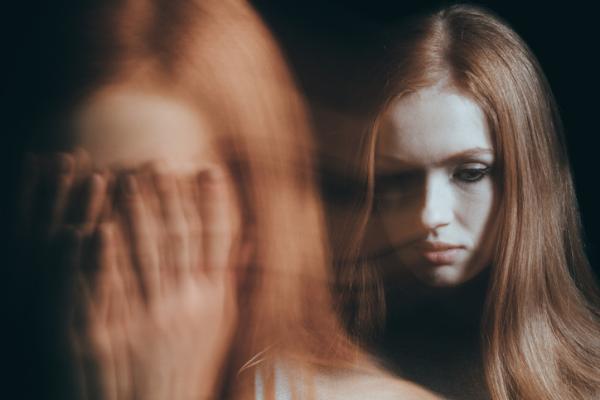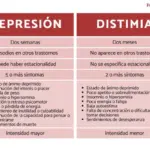
As their name implies, mood disorders are defined by pathological extremes of certain moods—specifically, sadness and euphoria. While sadness and elation are normal and natural, they can become overbearing and debilitating, and can even lead to death, in the form of suicide or as a result of reckless behavior. In the same year, approximately 7% of Americans suffer from mood disorders. We invite you to continue reading this PsychologyFor article if you want to know more about mood disorders
Major Depression
The cardinal symptoms of major depressive disorder They are depressed mood and loss of interest or pleasure. Other symptoms vary greatly. For example, sleep and weight loss are considered classic signs, although many depressed patients gain weight and sleep excessively.
It’s twice more common in women than in men
What is now called major depressive disorder, however, differs quantitatively and qualitatively from normal sadness or grief. Normal states of dysphoria (a negative or aversive mood state) are typically less pervasive and generally operate over a more limited time course. On the other hand, some of the symptoms of major depression, such as anhedonia (the inability to experience pleasure), despair, and loss of mood reactivity (the ability to feel a lift in mood in response to something positive) rarely accompany “normal” sadness. Suicidal thoughts and psychotic symptoms such as delusional ideas or visual hallucinations always signify a pathological state.
When a major depressive episode is left untreated, it can last an average of 9 months. Eighty to 90 percent of individuals will remit within 2 years of the first episode (Kapur and Mann, 1992). After that, at least 50 percent of depressions will recur, and after three or more episodes, the chances of recurrence within 3 years increase to 70 to 80 percent if the patient has had no treatment. preventive (Thase and Sullivan, 1995).
Anxiety is commonly comorbid with (occurring at the same time as) major depression. About half of people with a primary diagnosis of major depression also have an anxiety disorder (Barbee, 1998; Regier et al., 1998). The comorbidity of anxiety and depression is so pronounced that it has led to theories that they have similar etiologies (causes), which are discussed below. Twenty-four to 40 percent of individuals with mood disorders also suffer from substance abuse disorders in the United States (Merikangas et al., 1998). Without treatment, substance abuse worsens the course of mood disorders. Other common comorbid disorders include personality disorders (DSM-IV) and medical illness, especially chronic conditions such as hiptension (high blood pressure) and arthritis.
suicide It is the most feared complication of major depressive disorder. About 10 to 15 percent of patients previously hospitalized for depression commit suicide (Angst et al., 1999). Major depressive disorder accounts for about 20 to 35 percent of all suicide deaths (Angst et al., 1999). Suicide is more common among those with more severe and/or psychotic symptoms, with late onset, with the coexistence of mental and addictive disorders (Angst et al., 1999), as well as among those who have experienced stressful life events, who have illnesses medical, and who have a family history of suicidal behavior (Blumenthal, 1988). In the United States, men commit suicide four times more often than women; Suicide attempts occur four times more frequently in women than in men (Blumenthal, 1988).
Dysthymia It is a chronic form of depression (recurrent, usually less severe).
Depression is related, of course, to sadness. Sadness is a natural response to difficult circumstances that cannot be resolved by escaping (such as fear) or attacking the problem (such as anger). Instead, the sense is given that one must wait for the problem to solve it for oneself. In grief, for example, we believe that, ultimately, only time will lessen the pain.
We consider that sadness has become pathological when we lose that sense that the pain will decrease. We continue to suffer, we have feelings of guilt, we think obsessively about the problem, we even try to bottle up our feelings in general. Traumatic events such as the illness or death of a loved one are common causes of depression.
But continuous stress is also a common cause of depression. Stressful living causes depletion of the body’s resources, including changes in the availability of neurotransmitters associated with energy, happiness, and calm. With repeated stress, the nervous system becomes increasingly sensitive to the additional stress, until it can’t seem to cope anymore. A simple way to say this is that you become emotionally exhausted from life’s difficulties.
We find Depression most commonly occurs in people living in poverty, discrimination, and exploitation It is no surprise that 70% of depressed people are women, and living in a male-dominated society adds more stresses that women must endure. It is also more common among people in stigmatized populations. Cultural psychologist Richard Castillo even suggests that treating depression as a “brain disease” is society’s way of avoiding addressing the significant social problems that lead to depression, in the same way as focusing on “taking action.” in drug addicts or petty criminals allows us to ignore the social situations that lead people to engage in these behaviors.
A well-known explanation of depression sees it as a matter of learned helplessness. If we see ourselves as helpless in the face of stress and trauma, if we see our suffering as hopeless, we develop depression. This leaves a dilemma for psychologists: It often helps people to view depression as a “brain disease” involving low levels of serotonin, since they can no longer consider themselves somehow responsible for their condition. But that also means that they now see depression as something that can only be helped by outside medical intervention.
Depression is not as common in many non-Western and pre-modern cultures. In these cultures, emotional exhaustion is more likely to be expressed through somatization, that is, in the form of physical complaints. Castillo suggests that the prevalence of depression in modern Western societies such as the US is due to our emphasis on financial success, material values, and the idea that each of us has individual responsibility for our own happiness. In other societies, people rely more on a defined status, tradition, and the social support of the extended family. In other societies too, people do not see happiness as a right. In the US, if you’re not happy, we assume something terribly bad is happening!

Bipolar disorder
bipolar disorder is a recurrent mood disorder that features one or more episodes of mania or mixed episodes of mania and depression (DSM-IV; Goodwin & Jamison, 1990). Bipolar disorder is distinct from major depressive disorder by a history of (milder, nonpsychotic) manic or hypomanic episodes.
The mania It is derived from a French word that literally means maddened or frantic. The mood disorder can range from pure euphoria (great happiness) or from euphoria to irritability or to an unstable (changeable) mixture that also includes dysphoria (unhappiness) (Table 4-4). The content of thought is generally grandiose but can also be paranoid. Grandiosity generally takes the form of overvalued ideas (eg, “my book is the best written ever”) and downright delusional ideas (eg, “I have radio transmitters implanted in my head and the Martians are monitoring my thoughts“.”) Auditory and visual hallucinations complicate the most severe episodes. The speed of thoughts and ideas typically compete with the manic person’s consciousness. However, distractibility and poor concentration commonly impair implementation. judgment may also be seriously compromised; Compulsive spending, offensive or disinhibited behavior, and promiscuity or other objectively reckless behavior are also common. Subjective energy, libido (sexual desire), and increased activity but a reduced perceived need for sleep can undermine physical reserves. Sleep deprivation can also exacerbate (worse) cognitive difficulties and contribute to the development of catatonia (remaining in one position for long periods of time) or a florid (fully developed) disconcerting state known as delusional mania.
Cyclothymia It is marked by manic and depressive states, but not of sufficient intensity or duration to merit a diagnosis of bipolar disorder or major depressive disorder.
Mania is likely to involve a certain amount of dissociation – that is, a refocusing of attention away from painful situations (especially social) and onto a powerful, grandiose fantasy. Bipolar disorder may be a matter of an energetic fantasy phase followed by emotional exhaustion followed by another energetic fantasy phase, and so on.
Mania is sometimes associated with creativity, and a number of famous writers, artists, musicians, and other celebrities are believed to have been bipolar. They may be depressed for months, then have bursts of energetic creative activity, only to fall back into depression.
People believed to have been bipolar include Louis von Beethoven, Abraham Lincoln, Winston Churchill, Isaac Newton, Charles Dickens, Edgard Allan Poe, Mark Twain, Virginia Woolf, Kurt Vonnegut, Edvard Munch, Vincent van Gogh, Marilyn Monroe, Jimmy Hendrix, Sting, Ozzie Osbourne, Adam Ant, and Kurt Cobain.
This article is merely informative, at PsychologyFor we do not have the power to make a diagnosis or recommend a treatment. We invite you to go to a psychologist to treat your particular case.
If you want to read more articles similar to Mood disorders we recommend that you enter our Clinical Psychology category.








